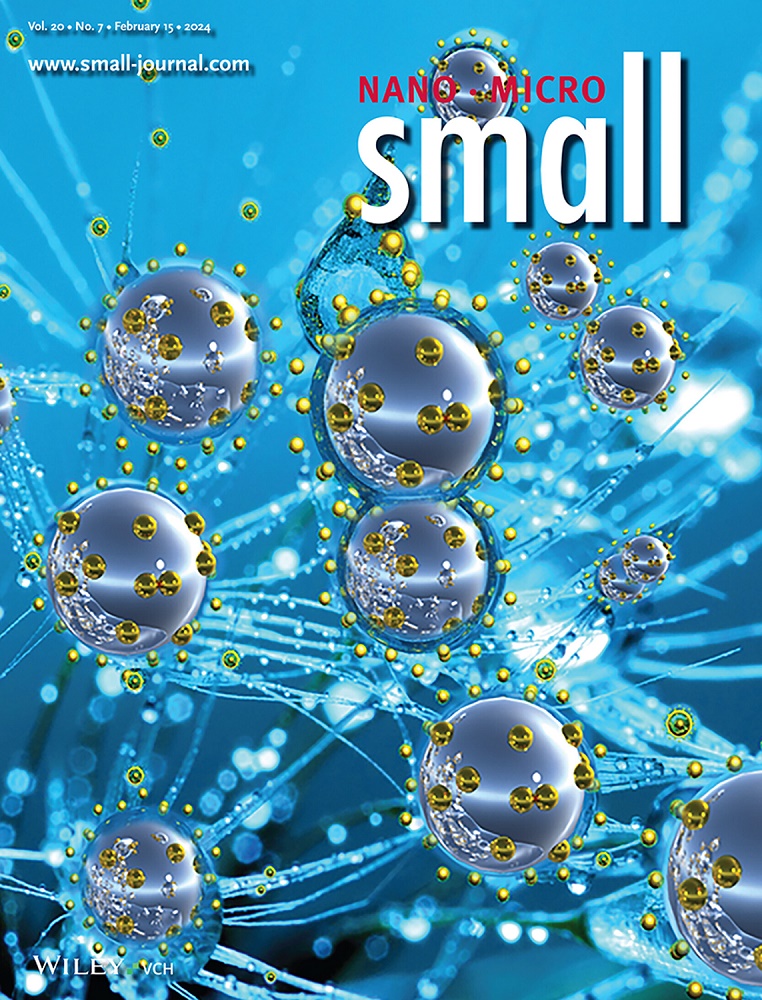颜色可调有机纳米点:合成及其在颜色转换和安全油墨中的应用
IF 12.1
2区 材料科学
Q1 CHEMISTRY, MULTIDISCIPLINARY
引用次数: 0
摘要
本研究探索了水基可调色有机纳米点(CTONDs)的合成,该纳米点能够通过调节粒子中蓝色、绿色和红色荧光团的摩尔比来发射多种颜色,包括白光。光谱分析表明,发射是由于能量供体和受体纳米粒子之间的福斯特共振能量转移(FRET)。由于纳米粒子在膜态时的紧密堆积,使得纳米粒子在膜态时的能量传递效率很高,达到90%以上。不同的摩尔比在液体分散体和固体分散体中产生不同的颜色。当作为发光器件中的颜色转换层(ccl)应用时,这些CTONDs显示出超过60%的颜色转换效率(CCE),在环境条件下保持超过四个月的光稳定性。此外,它们的水性可加工性和多色可调性使它们对环保显示技术、柔性光电子和防伪应用(如安全油墨)具有吸引力。这项工作提供了一种可扩展和可持续的方法来制造可调谐的,溶液处理的荧光有机纳米材料,并强调了它们作为下一代光子和光电子应用的多功能平台的前景。本文章由计算机程序翻译,如有差异,请以英文原文为准。
Color‐Tunable Organic Nano‐Dots: Synthesis and Applications in Color Conversion and Security Inks
This study explores the synthesis of water‐based color‐tunable organic nanodots (CTONDs) capable of emitting multiple colors, including white light, by adjusting the molar ratio of blue, green, and red emissive fluorophores in the particles. Spectroscopic analyses reveal that the emissions are due to Forster resonance energy transfer (FRET) between the energy donor and acceptor nanoparticles. The energy transfer efficiencies are high, reaching over 90% in the film state due to the close packing of NDs while in their film state. Various molar ratios produced different colors in both liquid dispersions and in the solid state. These CTONDs demonstrate over 60% color conversion efficiency (CCE) when applied as color conversion layers (CCLs) in light‐emitting devices, maintaining photostability for over four months under ambient conditions. Additionally, their aqueous processability and multicolor tunability make them attractive for environmentally friendly display technologies, flexible optoelectronics, and anti‐counterfeiting applications such as security inks. This work offers a scalable and sustainable approach to fabricating tunable, solution‐processed fluorescent organic nanomaterials and underscores their promise as a versatile platform for next‐generation photonic and optoelectronic applications.
求助全文
通过发布文献求助,成功后即可免费获取论文全文。
去求助
来源期刊

Small
工程技术-材料科学:综合
CiteScore
17.70
自引率
3.80%
发文量
1830
审稿时长
2.1 months
期刊介绍:
Small serves as an exceptional platform for both experimental and theoretical studies in fundamental and applied interdisciplinary research at the nano- and microscale. The journal offers a compelling mix of peer-reviewed Research Articles, Reviews, Perspectives, and Comments.
With a remarkable 2022 Journal Impact Factor of 13.3 (Journal Citation Reports from Clarivate Analytics, 2023), Small remains among the top multidisciplinary journals, covering a wide range of topics at the interface of materials science, chemistry, physics, engineering, medicine, and biology.
Small's readership includes biochemists, biologists, biomedical scientists, chemists, engineers, information technologists, materials scientists, physicists, and theoreticians alike.
 求助内容:
求助内容: 应助结果提醒方式:
应助结果提醒方式:


